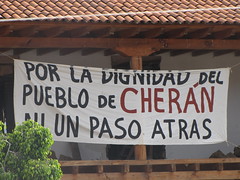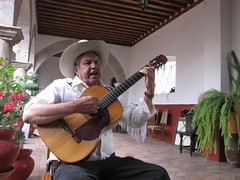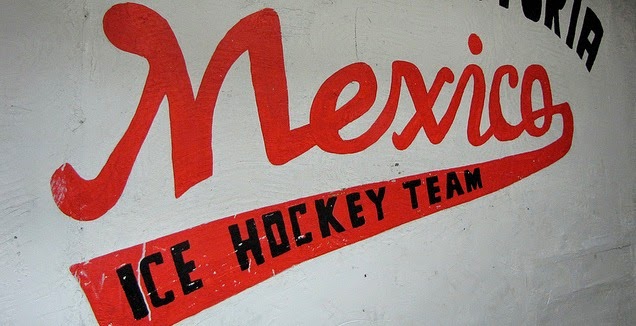11 November 2011
Interior Minister perishes in helicopter crash
Mexican Interior Minister Francisco Blake Mora died Friday in a helicopter crash, the second time in three years the most senior member of President Felipe Calderón’s cabinet has perished in an aviation disaster.
Federal government spokeswoman Alejandra Sota confirmed the death shortly after 12:30 p.m. local time. The crash, just to the southeast of Mexico City, claimed the lives of Blake, 45, along with seven passengers and crew. There were no survivors. Calderón was reported en route to the crash site. It's uncertain if he will depart later on Friday for APEC meetings as originally planned.
Blake becomes the second interior minister to suffer an untimely death in barely three years. Former interior Juan Camilo Mouriño perished Nov. 4, 2008, when his small jet plunged into a street in the swank Lomas de Chapultepec neighbourhood. Investigators blamed the crash involving Mouriño – long the domain of conspiracy theories – on pilot error.
Both men were key figures in the country's national security cabinet and coordinating security matters during a time that organized crime violence increasingly spread into previously placid pockets of Mexico.
Aviation crashes involving senior government officials have been distressingly frequent over the past decade. Colima governor Gustavo Vázquez died in a 2005 plane crash. More recently, a helicopter belonging to the Mexico state government crashed last month in the Coyoacán borough of Mexico City, killing two state officials. Billionaire businessman Moisés Saba died in a helicopter crash during bad weather in the western part of the Federal District in January 2010.
It's still uncertain who might replace Blake as interior minister, the most senior cabinet position and one responsible for internal security and overseeing agencies ranging from the National Immigration Institute to civil protection to Cisen, the country's intelligence service. The interior minister also acts as a liaison between the federal government and Congress and the 31 state governments.
Blake Mora was an unlikely choice for interior minister, having previously spent most of his political career in the Baja California state government and serving with Calderón in the federal lower house of Congress.
He sas the fourth interior minister of the Calderón administration and he replaced a political heavyweight: Fernando Gómez-Mont, one of the country's top lawyers and a close associate of none other than Diego Fernández de Cevallos – better known as "Jefe Diego." Gómez-Mont left cabinet after disagreeing with Calderón over the National Action Party's decision to pursue electoral alliances with the Mexican left in order to topple governments in six of the country's most retrograde Institutional Revolutionary Party (PRI) backwaters, including Oaxaca and Puebla.
A distraught-looking Calderón eulogized Blake during comments to the nation shortly after 2:30 p.m., describing the fathar of two as dedicated to his country and someone who emerged from working class roots in Tijuana to earn a law degree and ascend to top positions in the Baja California and federal governments.
No details on the cause of the crash were given.
03 November 2011
More from Michoacán
A poll published Nov. 3 in the Reforma newspaper gives PAN candidate Luisa María Calderón a six-point advantage in the Michoacán gubernatorial contest. Left unanswered is how the Nov. 2 assassination of La Piedad mayor Ricardo Guzmán Romero as he campaigned for Calderón will impact the Nov. 13 election in Michoacán, where the quasi religious drug cartel La Familia Michoacana and a splinter group, Knights Templar, are disputing the state.
It's probable, as happened in Tamaulipas after the assassination of PRI gubernatorial frontrunner Rodolfo Torre Cantú, voter turnout will plunge – something which favours the PRI (witness the low participation in the State of Mexico) as the party gets its mostly poor "voto duro" to the polls with inducements and coercive tactics and the middle classes stay home.
The Reforma poll showed Calderón – a former senator best known for crossing swords with "Jefe Diego" and the sister of President Felipe Calderón – receiving 39 percent support, six points better than PRI candidate Fausto Vallejo. The PRD campaign of Sen. Silvano Aureoles was running a distant third with 28 percent support. More importantly for Calderón the poll showed her campaign gaining ground: Support increased by 10 percentage points from the last Reforma poll in September, while the PRI and PRD campaigns lost ground.
A Calderón victory would bolster the president as he attempts to establish some sort of lasting political legacy for the PAN, which has struggled in local elections during his administration and appears set to be voted from power on the federal level in the July 1, 2012 national elections.
The results could prove disastrous for the PRD. The party has been beset by infighting and its plans to name the 2012 presidential candidate from a poll is expected to generate discontent among the losing side – be it 2006 candidate Andrés Manuel López Obrador or Mexico City Mayor Marcelo Ebrard. The party already has lost the stronghold states of Baja California Sur and Zacatecas. Michoacán, where the party also has been rife with infighting, appears to be next.
The PRI is running competitive in Michoacán, but its campaign has yet to capture any serious momentum – spare the moments when the party's presidential frontrunner Enrique Peña Nieto showed up for a day of campaigning.
One observer, parish priest Jesús Alfredo Gallegos Lara – better known as "Padre Pistolas" – cast some doubt on the Reforma poll, saying the survey was done by telephone in a state where "many of the ranchos don't have phones." The PRD, he told me, draws most of its support from the ranchos.
02 November 2011
PAN mayor shot dead

A sign in the Cherán, Michoacán, town plaza strikes a rebellious note. The town rebelled against illegal loggers clear-cutting the local hills with the help of armed criminal groups earlier this year – and ran off the local mayor, too. Michoacán electoral officials want there to be a vote in Cherán, but locals say they won't allow political parties to participate.
The PAN mayor of La Piedad was shot dead while campaigning Nov. 2, casting doubt on the ability to hold general elections across the oft-violent state of Michoacán in 10 days time – and also casting doubt on the ability to hold federal electoral races next year in the pockets of Mexico where organized crime violence has been rife.
Ricardo Guzmán Romero was fatally shot while campaigning for the PAN candidate in the pork-processing town of La Piedad, PAN officials said via Twitter. The circumstances of the assassination remain uncertain, but PAN youth president Jhonathan García, who was witness to the shooting, said via Twitter that the mayor was shot in the abdomen. Press reports say Guzmán was passing out pamphlets when attacked.
Michoacán Gov. Leonel Godoy scheduled a press conference for 9 p.m. local time. Guzmán became the fourth Michoacán mayor to be assassinated since Godoy took office in early 2008, Michoacán news agency Quadratín reported.
Voters in Michoacán go to the polls Nov. 13 in an election Luisa María Calderón, sister of President Felipe Calderón, hopes to win for the PAN. Public opinion polls vary. An Agencia Mendoza Blanco y Asociados survey shows a tight, three-way PAN-PRI-PRD contest, while Gabinete de Comunicación Estratégica gave Calderón 39-36 lead over PRI candidate Fausto Vallejo. PRD candidate Silvano Aureoles Conejo trailed with 25 percent support, setting up a potential embarrassment for the PRD, which had dominated Michoacán politics for the past decade.
The assassination marked the latest difficulty for Michoacán's electoral process, which will renew the governor's office, local congress and 113 municipal governments. The state electoral institute reports the withdrawal of 51 candidates, according to the newspaper El Universal. The PAN-New Alliance coalition, meanwhile, was unable to find candidates in at least 10 municipalities.
Residents of Cherán, where locals ran off illegal loggers, organized crime, the police and the mayor, refuse to allow political parties to run candidates, even though the electoral institute insists on there being a vote.
Violence, of course, predates the election in Michoacán, where La Familia Michoacana and a splinter group, the quasi-religious Knights Templar, are disputing the state. Michoacán native Felipe Calderón sent troops to Michoacán shortly after taking office – the first such deployment of his administration.
20 September 2011
Presidential front-runner declares his intentions

Former State of Mexico governor Enrique Peña Nieto speaks Sept. 14 to residents of a flooded out neighbourhood in Cuautitlán after distributing pre-paid cards for replacing damaged furniture and appliances. His term as governor ended the next day and he now is pursuing the PRI presidential nomination.
To no one's surprise, former State of Mexico governor Enrique Peña Nieto acknowledged his plans to run for the Institutional Revolutionary Party (PRI) presidential nomination. Even less surprising, he did so while appearing on Televisa, the media empire long-accused of providing him with plenty of favourable coverage – and exposing him frequently to a nationwide audience in a country where most people get their news via television broadcasts – during his six-year gubernatorial administration.
Derisively branded "Gel Boy" (pronounced, "hell-boy," in Spanish) by detractors for the copious amounts of gel in his hairstyle, Peña Nieto enters the contest with a massive lead among over any of the probable presidential candidates as the governing National Action Party (PAN) appears spent after 11 years in power and President Felipe Calderón lacks a popular heir-apparent. The left-leaning Democratic Revolution Party (PRD), meanwhile, has been plagued by infighting since nearly capturing power in 2006 and its nomination process is another civil war waiting to happen.
The 45-year-old Peña Nieto puts a young face on an old-school PRI, which has recovered from losing the presidency in 2000 and being decimated in 2006 (after vicious infighting) and has gone on to dominate politics on the local level – and become a party of powerful state governors, who preside over jurisdictions with little transparency and weak autonomous institutions.
He hails from a political clan known as "Grupo Atlacomulco," which has wielded power in the State of Mexico for decades and grew rich from the largess of generous government concessions. Its most famous patriarch, former State of Mexico governor and Mexico City regent, Carlos Hank Gónzalez, coined the infamous Mexican political maxim, "A politician who is poor, is a poor politician." Peña Nieto appears to have the backing of the church hierarchy, too – something unthinkable a generation ago for a PRI politician.
Peña Nieto will likely face PRI Senate leader Manlio Fabio Beltrones in the nomination battle – and emerge the victor: The State of Mexico carries enormous weight in PRI matters. Additionally, his reputation has been burnished by having presided over an administration savvy in public relations and which focused heavily on the completion of public works projects. He also survived fiascoes unscathed, such as the botched Paulette investigation in 2010 – in which a four-year-old girl was found dead in her own bed nine days after investigators supposedly had searched her room – or his fumbling for answers during a television interview when explaining the circumstances of his first wife's death.
His current wife, soap opera star Angelica Rivera, draws no shortage of favourable coverage, too – and their union was made possible after the Archdiocese of Mexico City annulled her first marriage because it took place on a beach in Acapulco. Even his teenage daughter was named one of the 10 hottest girls in Mexico by Quién, a society magazine.
The former governor has outlined no specific plans for a PRI administration, although the behaviour of the PRI delegation in the lower house of Congress – which he heavily influences – might offer hints at what to expect. The PRI delegation has thwarted attempts at labour reform, failed to pass money laundering and national security laws, steadfastly opposed the reelection of politicians and has fought every year during the budget process to devolve ever more money to opaque state governments,
Even details of his accomplishments seem vague – such as the claim made in his final informe (state of the state address) that the homicide rate dropped by half in the State of Mexico during his administration and doubled in the rest of the country. This all at a time when at least four cartels have battled for territory in the suburbs of Mexico City and the neighbouring Federal District has remained relatively free of organized crime nonsense.
During recent reporting trips to the State of Mexico, people have carried on enthusiastically in interviews about how Peña Nieto has kept his word and improved life in the state. When asked to provide examples, the conversation usually turns to some distant project, which quite possible included federal funding, or highways charging tolls far beyond what an ordinary motorist might be able to afford.
When posed with questions about security, everyone says it has worsened – especially for anyone riding the over-priced public transit network in the State of Mexico, which has been a target for armed thugs in recent years. But, again, they seem willing to give Peña Nieto the benefit of the doubt, proving that voters overwhelmingly view security as a federal matter and seldom will hold a local mayor or governor responsible. Some interviewees even figured the arrival of a priísta in Los Pinos would somehow bring the crime problem under control – just like during the "golden age" of PRI rule that so many in Mexico now have fond memories of recalling (when narcos were kept in check) and hope to see come to pass once again.
The presidential election goes down July 1, 2012, leaving time for the frontrunner to be reeled in – just like Calderón did with Andrés Manuel López Obrador in 2006. But how that might happen remains a mystery, especially when many voters appear apathetic about the political process (witness the low turnout in the July 2011 State of Mexico gubernatorial election,) young voters with more bad memories about the PAN in power than the PRI are actually opting for the PRI, and so many people, like one participant leaving comments on the Reforma website, gush enthusiastically, "Finally a primary candidate with a project and real proposals. Enrique Peña Nieto, President of Mexico!!"
28 August 2011
Padre Pistolas

Father Jesús Alfredo Gallegos Lara is better know as Padre Pistolas, a Michoacán priest famed throughout the region for packing heat and singing ranchera and mariachi music. He also has become famous for promoting public works projects - all to the dismay of his superior, the Archbishop of Morelia. The archbishop once suspended Father Gallegos, but politicians from all sides - who regularly seek out his endorsement, including PAN gubernatorial candidate Luisa Calderón, the president's sister - have urged Padre Pistolas to run for public office, knowing his popularity, moral authority and pull with the local population surpasses that of anyone else in church.
I visited with Padre Pistolas recently - hoping, course, he wouldn't pull out his Colt 45 and, say, "Vaya con Dios, muchacho!" He's folkloric, but also very dedicated to his work - and has done more to improve life in the rundown pueblos he serves than any other public figure. The story ran in The Globe and Mail (click the title of this post to read it.)
29 January 2011
'Acapulco is both heaven and hell'

A campaign launched by Acapulco night club owners encourages people to speak well of Acapulco. It comes as the granddaddy of Mexican tourist destinations suffers through a wave of organized crime bloodshed that has involved beheadings and mass abductions. Tourist officials say the violence takes place far away from tourist areas and doesn't impact visitors. They complain, too, that violence in other parts of Guerrero often is erroneously reported as somehow involving or being near Acapulco. I went to Acapulco recently to report on the situation for USA TODAY; read my dispatch by clicking on the headline for this blog post.
Subscribe to:
Posts (Atom)


